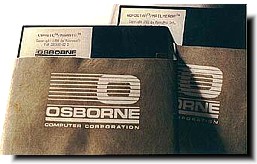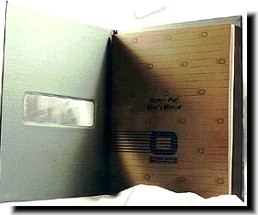 The Osborne 1 portable personal computer, open and ready for use. The screen unit fits into
slots on the keyboard unit. The 5-inch diagonal screen (that's 3 x 4 inches!) displayed some 60 print
columns and the software allowed left-right shifts to see the entire 80-column line. This model had dual
floppy drives, and an 'internal' modem in the left hand disk storage slot. The modem is connected by a
short jumper cable to the cabinet and has a conventional modular RJ-11 telephone plug. The socket on the
right could provide (with an adapter) an NTSC or standard TV monochrome signal to drive a (larger!) external
TV monitor. A RS232/serial port connector is found just to the right of the modem connector on the left side
of the chassis. This can be used for connecting a printer. To the right of the RS232/serial port is an
IEEE488 (also known as GPIB) port used to control some early printers as well as early lab equipment. A
connector to the far right of the front panel (to the right of the reset button) is to support and external battery.
The Osborne 1 portable personal computer, open and ready for use. The screen unit fits into
slots on the keyboard unit. The 5-inch diagonal screen (that's 3 x 4 inches!) displayed some 60 print
columns and the software allowed left-right shifts to see the entire 80-column line. This model had dual
floppy drives, and an 'internal' modem in the left hand disk storage slot. The modem is connected by a
short jumper cable to the cabinet and has a conventional modular RJ-11 telephone plug. The socket on the
right could provide (with an adapter) an NTSC or standard TV monochrome signal to drive a (larger!) external
TV monitor. A RS232/serial port connector is found just to the right of the modem connector on the left side
of the chassis. This can be used for connecting a printer. To the right of the RS232/serial port is an
IEEE488 (also known as GPIB) port used to control some early printers as well as early lab equipment. A
connector to the far right of the front panel (to the right of the reset button) is to support and external battery.
 The Osborne computer was marketed with a user-friendly User's Reference Guide by Thom Hogan & Mike Iannamico.
The Osborne computer was marketed with a user-friendly User's Reference Guide by Thom Hogan & Mike Iannamico.
 Osborne computer software disks that were distributed with the Osborne hardware. The Osborne computer was
marketed with a bundle of software which included CBASIC, MBASIC, dBase II, WordStar,
CalcStar, and MailMerge. Since each computer manufacturer used a proprietary disk format, it
was necessary to buy software specifically for the particular brand (and sometimes the model) of microcomputer.
Osborne computer software disks that were distributed with the Osborne hardware. The Osborne computer was
marketed with a bundle of software which included CBASIC, MBASIC, dBase II, WordStar,
CalcStar, and MailMerge. Since each computer manufacturer used a proprietary disk format, it
was necessary to buy software specifically for the particular brand (and sometimes the model) of microcomputer.
 The Osbourne Comm-Pac User's Manual accompanying computer software for the Osborne computer.
The Osbourne Comm-Pac User's Manual accompanying computer software for the Osborne computer.
 An Osborne 1 Computer Specifications Sheet. This early entry into the area of 'portable' computing
weighed in at a sprightly 26.2 pounds, and was powered by the popular Z80A processor, running at 4MHz. For
comparison, a variant of the Z80 is currently used in many graphing calculators.
An Osborne 1 Computer Specifications Sheet. This early entry into the area of 'portable' computing
weighed in at a sprightly 26.2 pounds, and was powered by the popular Z80A processor, running at 4MHz. For
comparison, a variant of the Z80 is currently used in many graphing calculators.
